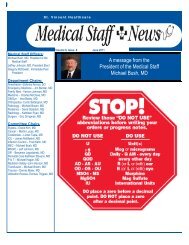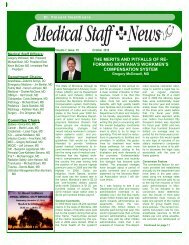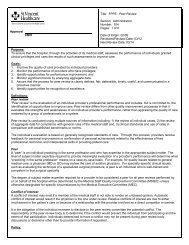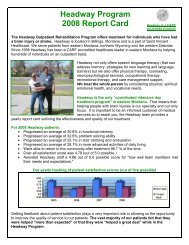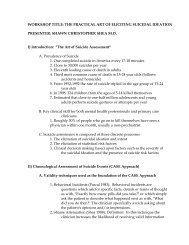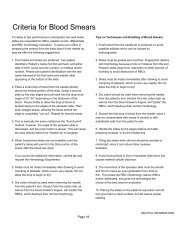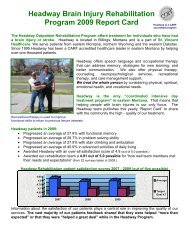AHA/ASA Guideline Guidelines for the Prevention of Stroke in ...
AHA/ASA Guideline Guidelines for the Prevention of Stroke in ...
AHA/ASA Guideline Guidelines for the Prevention of Stroke in ...
You also want an ePaper? Increase the reach of your titles
YUMPU automatically turns print PDFs into web optimized ePapers that Google loves.
252 <strong>Stroke</strong> January 2011Table 10.Cont<strong>in</strong>uedRisk FactorPostmenopausalhormone replacement<strong>the</strong>rapyUse <strong>of</strong> anticoagulationafter <strong>in</strong>tracranialhemorrhageSpecial approaches toimplement<strong>in</strong>gguidel<strong>in</strong>es and <strong>the</strong>iruse <strong>in</strong> high-riskpopulationsRecommendationsFor women who have had ischemic stroke or TIA, postmenopausal hormone <strong>the</strong>rapy (with estrogen with orwithout a progest<strong>in</strong>) is not recommended (Class III; Level <strong>of</strong> Evidence A).For patients who develop ICH, SAH, or SDH, it is reasonable to discont<strong>in</strong>ue all anticoagulants and antiplateletsdur<strong>in</strong>g <strong>the</strong> acute period <strong>for</strong> at least 1 to 2 weeks and reverse any warfar<strong>in</strong> effect with fresh frozen plasmaor prothromb<strong>in</strong> complex concentrate and vitam<strong>in</strong> K immediately (Class IIa; Level <strong>of</strong> Evidence B).Protam<strong>in</strong>e sulfate should be used to reverse hepar<strong>in</strong>-associated ICH, with <strong>the</strong> dose depend<strong>in</strong>g on <strong>the</strong> timefrom cessation <strong>of</strong> hepar<strong>in</strong> (Class I; Level <strong>of</strong> Evidence B). (New recommendation)The decision to restart antithrombotic <strong>the</strong>rapy after ICH related to antithrombotic <strong>the</strong>rapy depends on <strong>the</strong> risk<strong>of</strong> subsequent arterial or venous thromboembolism, risk <strong>of</strong> recurrent ICH, and overall status <strong>of</strong> <strong>the</strong> patient.For patients with a comparatively lower risk <strong>of</strong> cerebral <strong>in</strong>farction (eg, AF without prior ischemic stroke)and a higher risk <strong>of</strong> amyloid angiopathy (eg, elderly patients with lobar ICH) or with very poor overallneurological function, an antiplatelet agent may be considered <strong>for</strong> prevention <strong>of</strong> ischemic stroke. In patientswith a very high risk <strong>of</strong> thromboembolism <strong>in</strong> whom restart<strong>in</strong>g warfar<strong>in</strong> is considered, it may be reasonableto restart warfar<strong>in</strong> at 7 to 10 days after onset <strong>of</strong> <strong>the</strong> orig<strong>in</strong>al ICH (Class IIb; Level <strong>of</strong> Evidence B). (Newrecommendation)For patients with hemorrhagic cerebral <strong>in</strong>farction, it may be reasonable to cont<strong>in</strong>ue anticoagulation, depend<strong>in</strong>gon <strong>the</strong> specific cl<strong>in</strong>ical scenario and underly<strong>in</strong>g <strong>in</strong>dication <strong>for</strong> anticoagulant <strong>the</strong>rapy (Class IIb; Level <strong>of</strong>Evidence C).It can be beneficial to embed strategies <strong>for</strong> implementation with<strong>in</strong> <strong>the</strong> process <strong>of</strong> guidel<strong>in</strong>e development anddistribution to improve utilization <strong>of</strong> <strong>the</strong> recommendations (Class IIa; Level <strong>of</strong> Evidence B). (Newrecommendation)Intervention strategies can be useful to address economic and geographic barriers to achiev<strong>in</strong>g compliancewith guidel<strong>in</strong>es and to emphasize <strong>the</strong> need <strong>for</strong> improved access to care <strong>for</strong> <strong>the</strong> aged, underserved, andhigh-risk ethnic populations (Class IIa; Level <strong>of</strong> Evidence B). (New recommendation)Class/Level <strong>of</strong>Evidence*Class III; Level AClass IIa; Level BClass I; Level BClass IIb; Level BClass IIb; Level CClass IIa; Level BClass IIa; Level BAPL <strong>in</strong>dicates antiphospholipid; CVT, cerebral venous thrombosis; DVT, deep ve<strong>in</strong> thrombosis; SCD, sickle cell disease; SDH, subdural hematoma; and UFH,unfractionated hepar<strong>in</strong>.*See Tables 1 and 2 <strong>for</strong> explanation <strong>of</strong> class and level <strong>of</strong> evidence.size or presence <strong>of</strong> atrial septal aneurysm. No differences(HR, 1.17; P0.65) were seen <strong>in</strong> outcome <strong>in</strong> patients withcryptogenic stroke and PFO between those treated withaspir<strong>in</strong> (2-year event rates, 13.2%) versus warfar<strong>in</strong> (16.5%).Although <strong>the</strong>se data are from a randomized cl<strong>in</strong>ical trial, thissubstudy was not designed specifically to test <strong>the</strong> superiority<strong>of</strong> one medical treatment <strong>in</strong> this subset. 356In contrast, <strong>the</strong> European PFO-<strong>ASA</strong> study reported by Maset al 357 <strong>in</strong> 2002 reported recurrence rates <strong>of</strong> stroke on 4-yearfollow-up <strong>of</strong> 581 stroke patients with stroke <strong>of</strong> unknowncause. The patients were 18 to 55 years <strong>of</strong> age, and all weretreated with 300 mg <strong>of</strong> aspir<strong>in</strong>. The rate <strong>of</strong> recurrence was2.3% (0.3 to 4.3) <strong>in</strong> those with PFO alone, 15.2% (1.8 to 28.6)<strong>in</strong> patients with PFO and atrial septal aneurysm, and 4.2%(1.8 to 6.6) <strong>in</strong> patients with nei<strong>the</strong>r cardiac f<strong>in</strong>d<strong>in</strong>g. Theimportance <strong>of</strong> PFO with or without atrial septal aneurysm andits optimal treatment rema<strong>in</strong> <strong>in</strong> question. 357 Three largeprospective studies have exam<strong>in</strong>ed <strong>the</strong> risk <strong>of</strong> first stroke withPFO and cast doubt on <strong>the</strong> strength <strong>of</strong> <strong>the</strong> relationshipbetween PFO and stroke risk. 13,252,352,354More recently, Handke et al 358 exam<strong>in</strong>ed 503 consecutivepatients with stroke, <strong>in</strong>clud<strong>in</strong>g 227 patients with cryptogenicstroke and 276 patients with stroke <strong>of</strong> known cause. TEE wasper<strong>for</strong>med after stroke classification. PFO was detected more<strong>of</strong>ten <strong>in</strong> cryptogenic stroke <strong>for</strong> both younger patients (43.9%versus 14%; OR, 4.7; 95% CI, 1.89 to 11.68; P0.001) andolder patients (28.3% versus 11.9%; OR, 2.92; 95% CI, 1.70to 5.01; P0.001). An atrial septal aneurysm was presentwith a PFO <strong>in</strong> 13.4% versus 2.0% <strong>of</strong> younger patients(cryptogenic versus known; OR, 7.36; 95% CI, 1.01 to 326)and <strong>in</strong> older patients (15.2% versus 4.4%; OR, 3.88; 95% CI,1.78 to 8.49; P0.001). 358 The Prospective Spanish Multicenter(CODICIA) Study exam<strong>in</strong>ed 486 patients with cryptogenicstoke and quantified <strong>the</strong> magnitude <strong>of</strong> right-to-leftshunt us<strong>in</strong>g contrast transcranial Doppler ultrasonography.Massive right-to-left shunt was detected <strong>in</strong> 200 patients(41%). <strong>Stroke</strong> recurrence was low (5.8%) and was notassociated with <strong>the</strong> degree <strong>of</strong> <strong>the</strong> shunt. 359Given <strong>the</strong>se data, overall, <strong>the</strong> importance <strong>of</strong> PFO with orwithout atrial septal aneurysm <strong>for</strong> a first stroke or recurrentcryptogenic stroke rema<strong>in</strong>s <strong>in</strong> question. No randomizedcontrolled cl<strong>in</strong>ical trials compar<strong>in</strong>g different medical <strong>the</strong>rapies,medical versus surgical closure, or medical versustransca<strong>the</strong>ter closure have been reported, although severalstudies are ongo<strong>in</strong>g. Nonrandomized comparisons <strong>of</strong> variousclosure techniques with medical <strong>the</strong>rapy have generallyshown reasonable complication rates and recurrence riskwith closure at or below those reported with medical<strong>the</strong>rapy. 360–370 One study suggested a particular benefit <strong>in</strong>patients with 1 stroke at basel<strong>in</strong>e. 370In summary, <strong>the</strong>se studies provide new <strong>in</strong><strong>for</strong>mation onoptions <strong>for</strong> closure <strong>of</strong> PFO and generally <strong>in</strong>dicate thatshort-term complications with <strong>the</strong>se procedures are rare and<strong>for</strong> <strong>the</strong> most part m<strong>in</strong>or. Un<strong>for</strong>tunately, long-term follow-upis lack<strong>in</strong>g. Event rates over 1 to 2 years after transca<strong>the</strong>terclosure ranged from 0% to 3.4%. Studies <strong>in</strong> which closureDownloaded from stroke.ahajournals.org by on March 8, 2011



